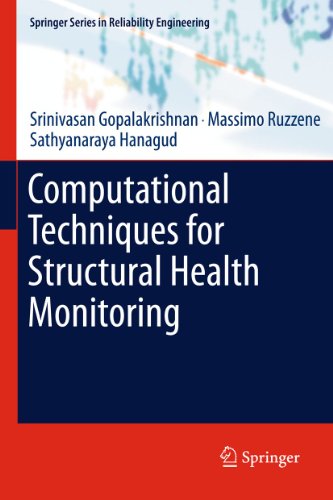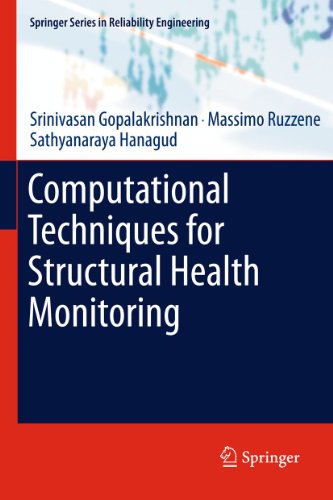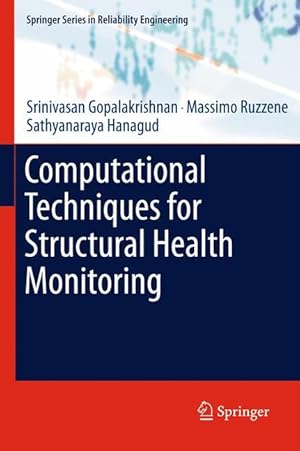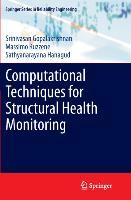Computational Techniques Structural Health by Gopalakrishnan Srinivasan (28 results)
Search filters
Product Type
- All Product Types
- Books (28)
- Magazines & Periodicals (No further results match this refinement)
- Comics (No further results match this refinement)
- Sheet Music (No further results match this refinement)
- Art, Prints & Posters (No further results match this refinement)
- Photographs (No further results match this refinement)
- Maps (No further results match this refinement)
- Manuscripts & Paper Collectibles (No further results match this refinement)
Condition Learn more
- New (23)
- As New, Fine or Near Fine (5)
- Very Good or Good (No further results match this refinement)
- Fair or Poor (No further results match this refinement)
- As Described (No further results match this refinement)
Binding
Collectible Attributes
- First Edition (No further results match this refinement)
- Signed (No further results match this refinement)
- Dust Jacket (No further results match this refinement)
- Seller-Supplied Images (12)
- Not Print on Demand (24)
Language (1)
Price
- Any Price
- Under £ 20 (No further results match this refinement)
- £ 20 to £ 35 (No further results match this refinement)
- Over £ 35
Free Shipping
Seller Location
Seller Rating
-
Computational Techniques for Structural Health Monitoring
Seller: GreatBookPrices, Columbia, MD, U.S.A.
Condition: New.
-
Computational Techniques for Structural Health Monitoring (Hardcover)
Published by Springer London Ltd, England, 2011
ISBN 10: 0857292838 ISBN 13: 9780857292834
Language: English
Seller: Grand Eagle Retail, Bensenville, IL, U.S.A.
Hardcover. Condition: new. Hardcover. The increased level of activity on structural health monitoring (SHM) in various universities and research labs has resulted in the development of new methodologies for both identifying the existing damage in structures and predicting the onset of damage that may occur during service. Designers often have to consult a variety of textbooks, journal papers and reports, because many of these methodologies require advanced knowledge of mechanics, dynamics, wave propagation, and material science. Computational Techniques for Structural Health Monitoring gives a one-volume, in-depth introduction to the different computational methodologies available for rapid detection of flaws in structures.Techniques, algorithms and results are presented in a way that allows their direct application. A number of case studies are included to highlight further the practical aspects of the selected topics. Computational Techniques for Structural Health Monitoring also provides the reader with numerical simulation tools that are essential to the development of novel algorithms for the interpretation of experimental measurements, and for the identification of damage and its characterization.Upon reading Computational Techniques for Structural Health Monitoring, graduate students will be able to begin research-level work in the area of structural health monitoring. The level of detail in the description of formulation and implementation also allows engineers to apply the concepts directly in their research. This one-volume, in-depth introduction to the computational methodologies available for rapid detection of flaws in structures covers techniques, algorithms and results in a way that facilitates their direct application, and includes a number of case studies. Shipping may be from multiple locations in the US or from the UK, depending on stock availability.
-
Computational Techniques for Structural Health Monitoring (Springer Series in Reliability Engineering)
Seller: Lucky's Textbooks, Dallas, TX, U.S.A.
Condition: New.
-
Computational Techniques for Structural Health Monitoring
Seller: GreatBookPrices, Columbia, MD, U.S.A.
Condition: New.
-
Computational Techniques for Structural Health Monitoring (Paperback)
Published by Springer London Ltd, England, 2013
ISBN 10: 1447126858 ISBN 13: 9781447126850
Language: English
Seller: Grand Eagle Retail, Bensenville, IL, U.S.A.
Paperback. Condition: new. Paperback. The increased level of activity on structural health monitoring (SHM) in various universities and research labs has resulted in the development of new methodologies for both identifying the existing damage in structures and predicting the onset of damage that may occur during service. Designers often have to consult a variety of textbooks, journal papers and reports, because many of these methodologies require advanced knowledge of mechanics, dynamics, wave propagation, and material science. Computational Techniques for Structural Health Monitoring gives a one-volume, in-depth introduction to the different computational methodologies available for rapid detection of flaws in structures.Techniques, algorithms and results are presented in a way that allows their direct application. A number of case studies are included to highlight further the practical aspects of the selected topics. Computational Techniques for Structural Health Monitoring also provides the reader with numerical simulation tools that are essential to the development of novel algorithms for the interpretation of experimental measurements, and for the identification of damage and its characterization.Upon reading Computational Techniques for Structural Health Monitoring, graduate students will be able to begin research-level work in the area of structural health monitoring. The level of detail in the description of formulation and implementation also allows engineers to apply the concepts directly in their research. This one-volume, in-depth introduction to the computational methodologies available for rapid detection of flaws in structures covers techniques, algorithms and results in a way that facilitates their direct application, and includes a number of case studies. Shipping may be from multiple locations in the US or from the UK, depending on stock availability.
-
Computational Techniques for Structural Health Monitoring (Springer Series in Reliability Engineering)
Seller: Lucky's Textbooks, Dallas, TX, U.S.A.
Condition: New.
-
Computational Techniques for Structural Health Monitoring (Springer Series in Reliability Engineering)
Seller: Ria Christie Collections, Uxbridge, United Kingdom
£ 134.13
Convert currency£ 11.98 shipping from United Kingdom to U.S.A.Quantity: Over 20 available
Add to basketCondition: New. In.
-
£ 121.74
Convert currency£ 42.53 shipping from Germany to U.S.A.Quantity: Over 20 available
Add to basketGebunden. Condition: New.
-
£ 121.74
Convert currency£ 42.53 shipping from Germany to U.S.A.Quantity: Over 20 available
Add to basketKartoniert / Broschiert. Condition: New.
-
Computational Techniques for Structural Health Monitoring
Seller: Books Puddle, New York, NY, U.S.A.
Condition: New. pp. 518.
-
Computational Techniques for Structural Health Monitoring
Published by Springer London, Springer London Aug 2011, 2011
ISBN 10: 0857292838 ISBN 13: 9780857292834
Language: English
Seller: buchversandmimpf2000, Emtmannsberg, BAYE, Germany
£ 143.50
Convert currency£ 52.09 shipping from Germany to U.S.A.Quantity: 2 available
Add to basketBuch. Condition: Neu. Neuware -The increased level of activity on structural health monitoring (SHM) in various universities and research labs has resulted in the development of new methodologies for both identifying the existing damage in structures and predicting the onset of damage that may occur during service. Designers often have to consult a variety of textbooks, journal papers and reports, because many of these methodologies require advanced knowledge of mechanics, dynamics, wave propagation, and material science. Computational Techniques for Structural Health Monitoring gives a one-volume, in-depth introduction to the different computational methodologies available for rapid detection of flaws in structures.Techniques, algorithms and results are presented in a way that allows their direct application. A number of case studies are included to highlight further the practical aspects of the selected topics. Computational Techniques for Structural Health Monitoring also provides the reader with numerical simulation tools that are essential to the development of novel algorithms for the interpretation of experimental measurements, and for the identification of damage and its characterization.Upon reading Computational Techniques for Structural Health Monitoring, graduate students will be able to begin research-level work in the area of structural health monitoring. The level of detail in the description of formulation and implementation also allows engineers to apply the concepts directly in their research.Springer Verlag GmbH, Tiergartenstr. 17, 69121 Heidelberg 516 pp. Englisch.
-
Computational Techniques for Structural Health Monitoring
Published by Springer London, Springer London Nov 2013, 2013
ISBN 10: 1447126858 ISBN 13: 9781447126850
Language: English
Seller: buchversandmimpf2000, Emtmannsberg, BAYE, Germany
£ 143.50
Convert currency£ 52.09 shipping from Germany to U.S.A.Quantity: 2 available
Add to basketTaschenbuch. Condition: Neu. Neuware -The increased level of activity on structural health monitoring (SHM) in various universities and research labs has resulted in the development of new methodologies for both identifying the existing damage in structures and predicting the onset of damage that may occur during service. Designers often have to consult a variety of textbooks, journal papers and reports, because many of these methodologies require advanced knowledge of mechanics, dynamics, wave propagation, and material science. Computational Techniques for Structural Health Monitoring gives a one-volume, in-depth introduction to the different computational methodologies available for rapid detection of flaws in structures.Techniques, algorithms and results are presented in a way that allows their direct application. A number of case studies are included to highlight further the practical aspects of the selected topics. Computational Techniques for Structural Health Monitoring also provides the reader with numerical simulation tools that are essential to the development of novel algorithms for the interpretation of experimental measurements, and for the identification of damage and its characterization.Upon reading Computational Techniques for Structural Health Monitoring, graduate students will be able to begin research-level work in the area of structural health monitoring. The level of detail in the description of formulation and implementation also allows engineers to apply the concepts directly in their research.Springer Verlag GmbH, Tiergartenstr. 17, 69121 Heidelberg 516 pp. Englisch.
-
£ 106.82
Convert currency£ 91.15 shipping from Germany to U.S.A.Quantity: 1 available
Add to basketCondition: Sehr gut. Zustand: Sehr gut | Sprache: Englisch | Produktart: Bücher.
-
Computational Techniques for Structural Health Monitoring (Springer Series in Reliability Engineering)
Seller: Ria Christie Collections, Uxbridge, United Kingdom
£ 184.13
Convert currency£ 11.98 shipping from United Kingdom to U.S.A.Quantity: Over 20 available
Add to basketCondition: New. In.
-
Computational Techniques for Structural Health Monitoring
Published by Springer London, Springer London, 2013
ISBN 10: 1447126858 ISBN 13: 9781447126850
Language: English
Seller: AHA-BUCH GmbH, Einbeck, Germany
£ 147.08
Convert currency£ 55.45 shipping from Germany to U.S.A.Quantity: 1 available
Add to basketTaschenbuch. Condition: Neu. Druck auf Anfrage Neuware - Printed after ordering - The increased level of activity on structural health monitoring (SHM) in various universities and research labs has resulted in the development of new methodologies for both identifying the existing damage in structures and predicting the onset of damage that may occur during service. Designers often have to consult a variety of textbooks, journal papers and reports, because many of these methodologies require advanced knowledge of mechanics, dynamics, wave propagation, and material science. Computational Techniques for Structural Health Monitoring gives a one-volume, in-depth introduction to the different computational methodologies available for rapid detection of flaws in structures.Techniques, algorithms and results are presented in a way that allows their direct application. A number of case studies are included to highlight further the practical aspects of the selected topics. Computational Techniques for Structural Health Monitoring also provides the reader with numerical simulation tools that are essential to the development of novel algorithms for the interpretation of experimental measurements, and for the identification of damage and its characterization.Upon reading Computational Techniques for Structural Health Monitoring, graduate students will be able to begin research-level work in the area of structural health monitoring. The level of detail in the description of formulation and implementation also allows engineers to apply the concepts directly in their research.
-
Computational Techniques for Structural Health Monitoring
Published by Springer London, Springer London, 2011
ISBN 10: 0857292838 ISBN 13: 9780857292834
Language: English
Seller: AHA-BUCH GmbH, Einbeck, Germany
£ 147.08
Convert currency£ 56.14 shipping from Germany to U.S.A.Quantity: 1 available
Add to basketBuch. Condition: Neu. Druck auf Anfrage Neuware - Printed after ordering - The increased level of activity on structural health monitoring (SHM) in various universities and research labs has resulted in the development of new methodologies for both identifying the existing damage in structures and predicting the onset of damage that may occur during service. Designers often have to consult a variety of textbooks, journal papers and reports, because many of these methodologies require advanced knowledge of mechanics, dynamics, wave propagation, and material science. Computational Techniques for Structural Health Monitoring gives a one-volume, in-depth introduction to the different computational methodologies available for rapid detection of flaws in structures.Techniques, algorithms and results are presented in a way that allows their direct application. A number of case studies are included to highlight further the practical aspects of the selected topics. Computational Techniques for Structural Health Monitoring also provides the reader with numerical simulation tools that are essential to the development of novel algorithms for the interpretation of experimental measurements, and for the identification of damage and its characterization.Upon reading Computational Techniques for Structural Health Monitoring, graduate students will be able to begin research-level work in the area of structural health monitoring. The level of detail in the description of formulation and implementation also allows engineers to apply the concepts directly in their research.
-
Computational Techniques for Structural Health Monitoring
Seller: Revaluation Books, Exeter, United Kingdom
£ 194.91
Convert currency£ 25 shipping from United Kingdom to U.S.A.Quantity: 2 available
Add to basketHardcover. Condition: Brand New. 516 pages. 9.25x6.25x1.25 inches. In Stock.
-
Computational Techniques for Structural Health Monitoring (Springer Series in Reliability Engineering)
Seller: Mispah books, Redhill, SURRE, United Kingdom
£ 197
Convert currency£ 25 shipping from United Kingdom to U.S.A.Quantity: 1 available
Add to basketPaperback. Condition: Like New. Like New. book.
-
Computational Techniques for Structural Health Monitoring
Seller: Revaluation Books, Exeter, United Kingdom
£ 198.32
Convert currency£ 25 shipping from United Kingdom to U.S.A.Quantity: 2 available
Add to basketPaperback. Condition: Brand New. 552 pages. 9.10x6.10x1.20 inches. In Stock.
-
Computational Techniques for Structural Health Monitoring
Seller: GreatBookPrices, Columbia, MD, U.S.A.
Condition: As New. Unread book in perfect condition.
-
Computational Techniques for Structural Health Monitoring (Springer Series in Reliability Engineering)
Seller: Mispah books, Redhill, SURRE, United Kingdom
£ 208
Convert currency£ 25 shipping from United Kingdom to U.S.A.Quantity: 1 available
Add to basketHardcover. Condition: Like New. Like New. book.
-
Computational Techniques for Structural Health Monitoring
Seller: GreatBookPrices, Columbia, MD, U.S.A.
Condition: As New. Unread book in perfect condition.
-
Computational Techniques for Structural Health Monitoring (Paperback)
Published by Springer London Ltd, England, 2013
ISBN 10: 1447126858 ISBN 13: 9781447126850
Language: English
Seller: AussieBookSeller, Truganina, VIC, Australia
£ 247.78
Convert currency£ 27.56 shipping from Australia to U.S.A.Quantity: 1 available
Add to basketPaperback. Condition: new. Paperback. The increased level of activity on structural health monitoring (SHM) in various universities and research labs has resulted in the development of new methodologies for both identifying the existing damage in structures and predicting the onset of damage that may occur during service. Designers often have to consult a variety of textbooks, journal papers and reports, because many of these methodologies require advanced knowledge of mechanics, dynamics, wave propagation, and material science. Computational Techniques for Structural Health Monitoring gives a one-volume, in-depth introduction to the different computational methodologies available for rapid detection of flaws in structures.Techniques, algorithms and results are presented in a way that allows their direct application. A number of case studies are included to highlight further the practical aspects of the selected topics. Computational Techniques for Structural Health Monitoring also provides the reader with numerical simulation tools that are essential to the development of novel algorithms for the interpretation of experimental measurements, and for the identification of damage and its characterization.Upon reading Computational Techniques for Structural Health Monitoring, graduate students will be able to begin research-level work in the area of structural health monitoring. The level of detail in the description of formulation and implementation also allows engineers to apply the concepts directly in their research. This one-volume, in-depth introduction to the computational methodologies available for rapid detection of flaws in structures covers techniques, algorithms and results in a way that facilitates their direct application, and includes a number of case studies. Shipping may be from our Sydney, NSW warehouse or from our UK or US warehouse, depending on stock availability.
-
Computational Techniques for Structural Health Monitoring (Hardcover)
Published by Springer London Ltd, England, 2011
ISBN 10: 0857292838 ISBN 13: 9780857292834
Language: English
Seller: AussieBookSeller, Truganina, VIC, Australia
£ 250.64
Convert currency£ 27.56 shipping from Australia to U.S.A.Quantity: 1 available
Add to basketHardcover. Condition: new. Hardcover. The increased level of activity on structural health monitoring (SHM) in various universities and research labs has resulted in the development of new methodologies for both identifying the existing damage in structures and predicting the onset of damage that may occur during service. Designers often have to consult a variety of textbooks, journal papers and reports, because many of these methodologies require advanced knowledge of mechanics, dynamics, wave propagation, and material science. Computational Techniques for Structural Health Monitoring gives a one-volume, in-depth introduction to the different computational methodologies available for rapid detection of flaws in structures.Techniques, algorithms and results are presented in a way that allows their direct application. A number of case studies are included to highlight further the practical aspects of the selected topics. Computational Techniques for Structural Health Monitoring also provides the reader with numerical simulation tools that are essential to the development of novel algorithms for the interpretation of experimental measurements, and for the identification of damage and its characterization.Upon reading Computational Techniques for Structural Health Monitoring, graduate students will be able to begin research-level work in the area of structural health monitoring. The level of detail in the description of formulation and implementation also allows engineers to apply the concepts directly in their research. This one-volume, in-depth introduction to the computational methodologies available for rapid detection of flaws in structures covers techniques, algorithms and results in a way that facilitates their direct application, and includes a number of case studies. Shipping may be from our Sydney, NSW warehouse or from our UK or US warehouse, depending on stock availability.
-
Computational Techniques for Structural Health Monitoring
Published by Springer London Nov 2013, 2013
ISBN 10: 1447126858 ISBN 13: 9781447126850
Language: English
Seller: BuchWeltWeit Ludwig Meier e.K., Bergisch Gladbach, Germany
£ 143.50
Convert currency£ 19.97 shipping from Germany to U.S.A.Quantity: 2 available
Add to basketTaschenbuch. Condition: Neu. This item is printed on demand - it takes 3-4 days longer - Neuware -The increased level of activity on structural health monitoring (SHM) in various universities and research labs has resulted in the development of new methodologies for both identifying the existing damage in structures and predicting the onset of damage that may occur during service. Designers often have to consult a variety of textbooks, journal papers and reports, because many of these methodologies require advanced knowledge of mechanics, dynamics, wave propagation, and material science. Computational Techniques for Structural Health Monitoring gives a one-volume, in-depth introduction to the different computational methodologies available for rapid detection of flaws in structures.Techniques, algorithms and results are presented in a way that allows their direct application. A number of case studies are included to highlight further the practical aspects of the selected topics. Computational Techniques for Structural Health Monitoring also provides the reader with numerical simulation tools that are essential to the development of novel algorithms for the interpretation of experimental measurements, and for the identification of damage and its characterization.Upon reading Computational Techniques for Structural Health Monitoring, graduate students will be able to begin research-level work in the area of structural health monitoring. The level of detail in the description of formulation and implementation also allows engineers to apply the concepts directly in their research. 516 pp. Englisch.
-
Computational Techniques for Structural Health Monitoring
Published by Springer London Aug 2011, 2011
ISBN 10: 0857292838 ISBN 13: 9780857292834
Language: English
Seller: BuchWeltWeit Ludwig Meier e.K., Bergisch Gladbach, Germany
£ 143.50
Convert currency£ 19.97 shipping from Germany to U.S.A.Quantity: 2 available
Add to basketBuch. Condition: Neu. This item is printed on demand - it takes 3-4 days longer - Neuware -The increased level of activity on structural health monitoring (SHM) in various universities and research labs has resulted in the development of new methodologies for both identifying the existing damage in structures and predicting the onset of damage that may occur during service. Designers often have to consult a variety of textbooks, journal papers and reports, because many of these methodologies require advanced knowledge of mechanics, dynamics, wave propagation, and material science. Computational Techniques for Structural Health Monitoring gives a one-volume, in-depth introduction to the different computational methodologies available for rapid detection of flaws in structures.Techniques, algorithms and results are presented in a way that allows their direct application. A number of case studies are included to highlight further the practical aspects of the selected topics. Computational Techniques for Structural Health Monitoring also provides the reader with numerical simulation tools that are essential to the development of novel algorithms for the interpretation of experimental measurements, and for the identification of damage and its characterization.Upon reading Computational Techniques for Structural Health Monitoring, graduate students will be able to begin research-level work in the area of structural health monitoring. The level of detail in the description of formulation and implementation also allows engineers to apply the concepts directly in their research. 516 pp. Englisch.
-
Computational Techniques for Structural Health Monitoring
Seller: Majestic Books, Hounslow, United Kingdom
£ 173.25
Convert currency£ 6.50 shipping from United Kingdom to U.S.A.Quantity: 4 available
Add to basketCondition: New. Print on Demand pp. 518.
-
Computational Techniques for Structural Health Monitoring
Seller: Biblios, Frankfurt am main, HESSE, Germany
£ 180.89
Convert currency£ 8.64 shipping from Germany to U.S.A.Quantity: 4 available
Add to basketCondition: New. PRINT ON DEMAND pp. 518.















